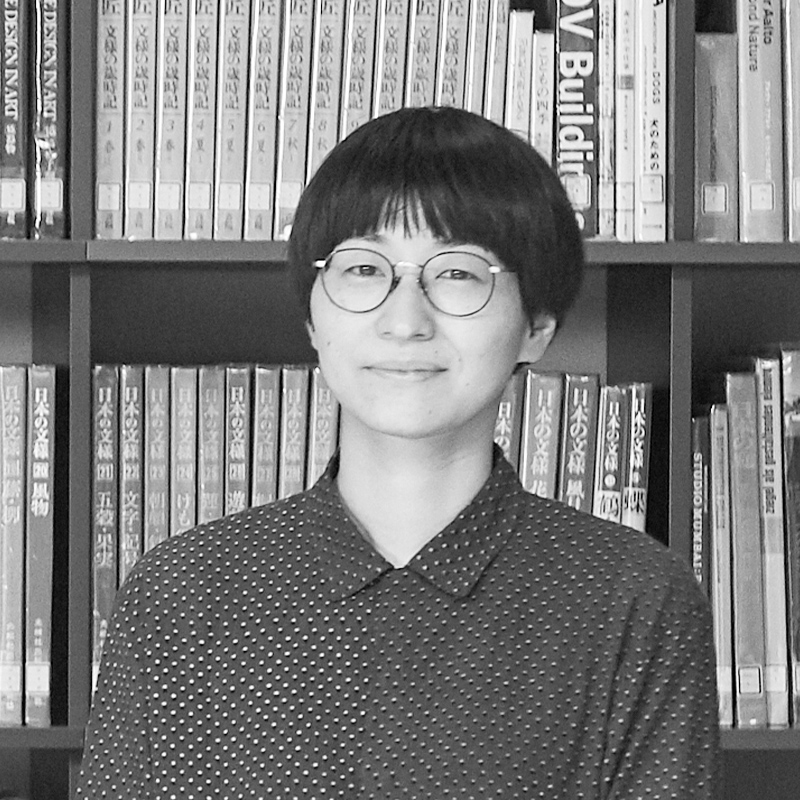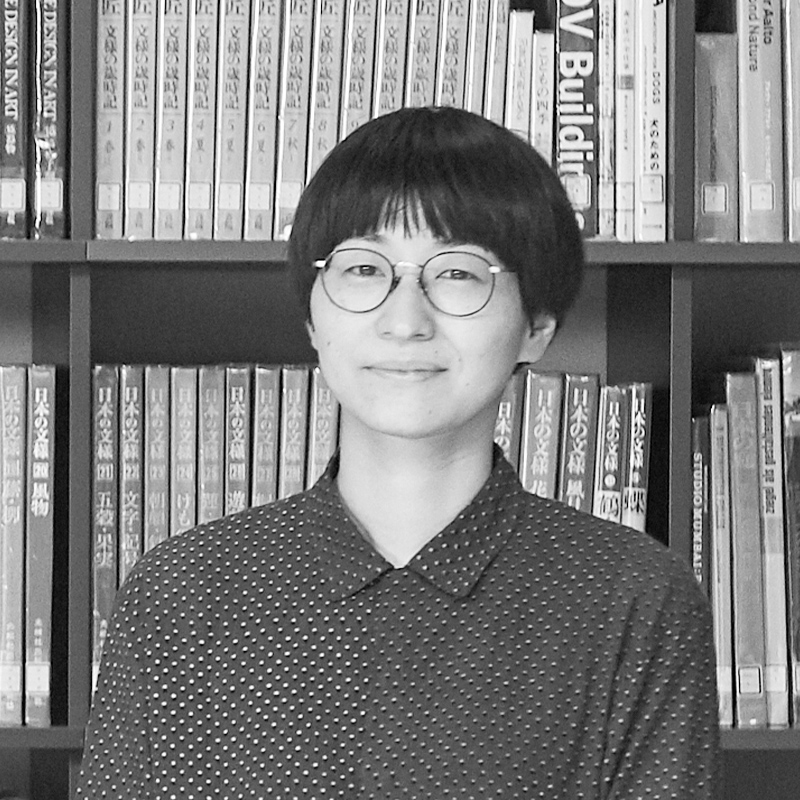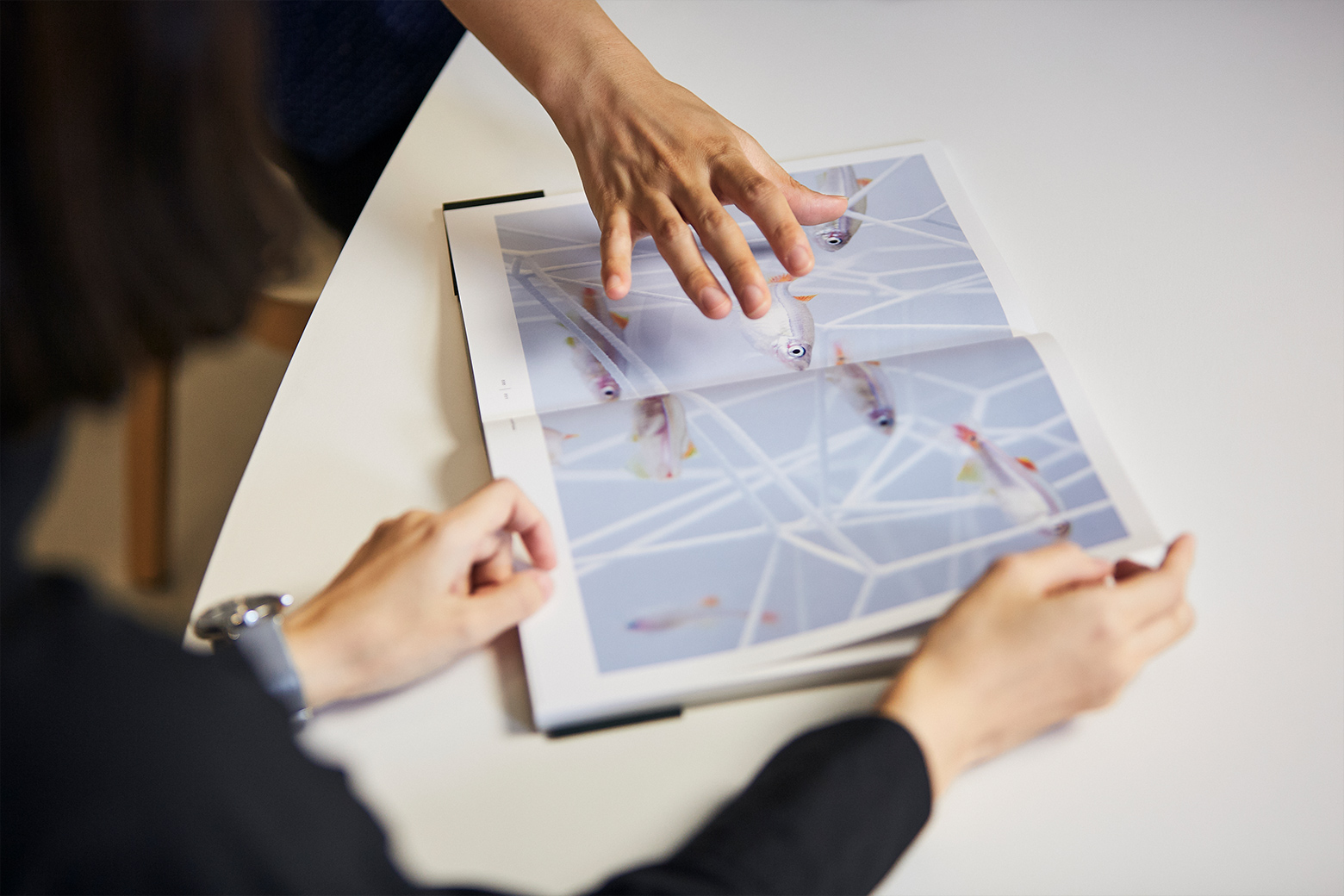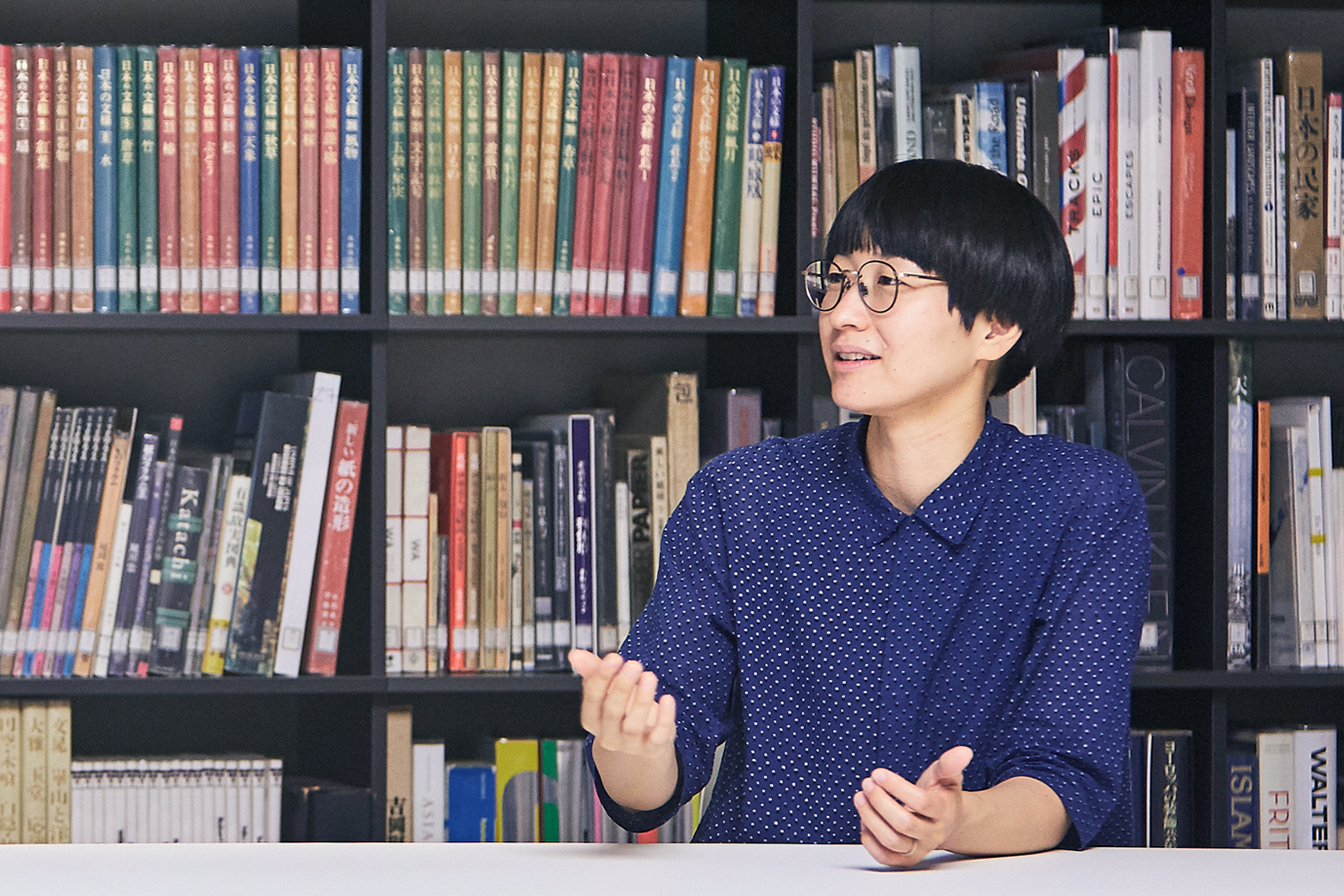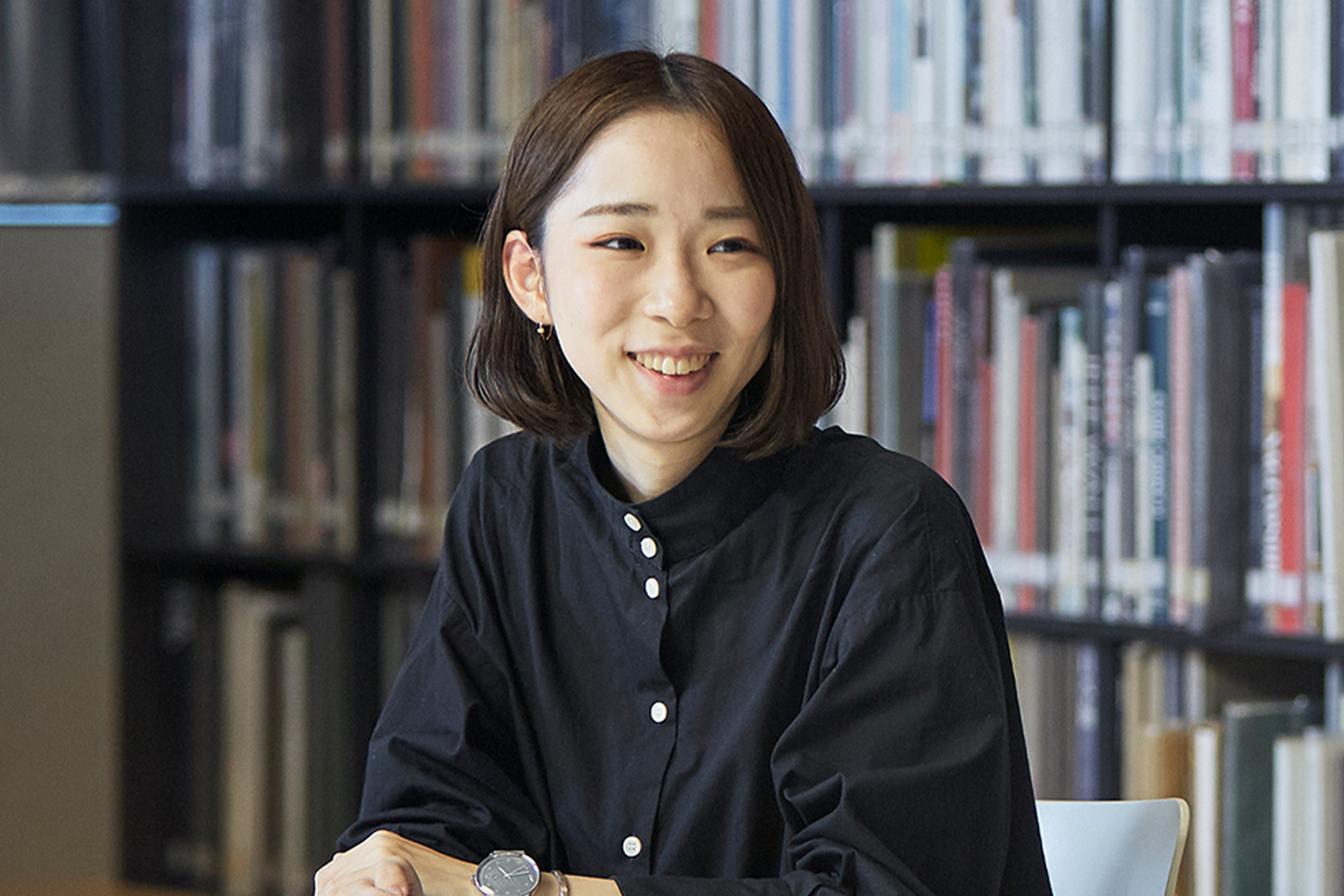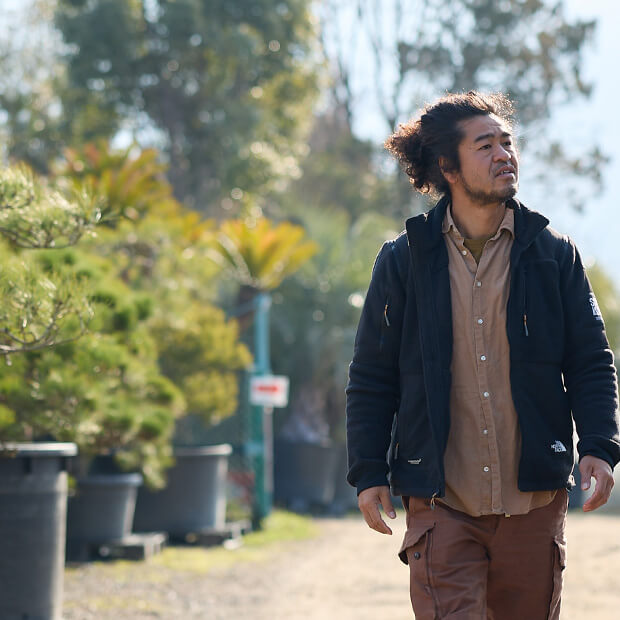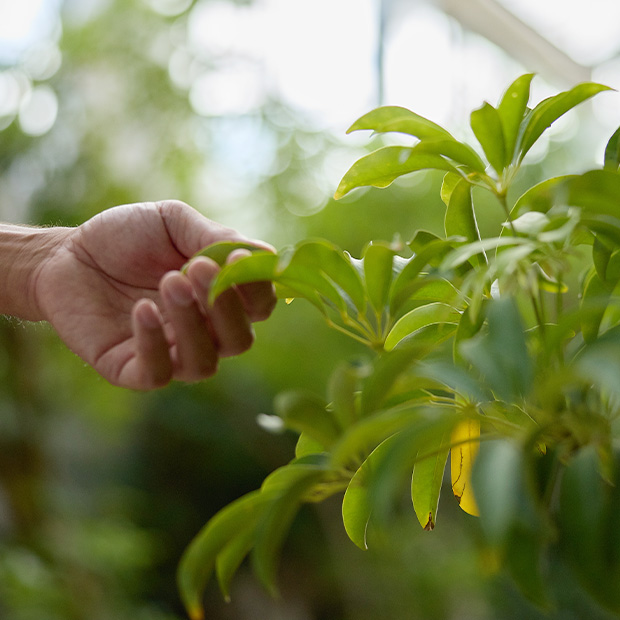Daikin designers value the relationship between design and air. In the series Inspire x D, we meet people who interest and inspire us and discuss various aspects of air with us as we explore the new possibilities of air through dialogue.
Known for her creative works such as waterscape and Paper Verb, Haruka Misawa is a designer who not only works in print and web graphics but is also involved in products and exhibitions. What is impressive about her projects is the richness in expression that evokes a feeling that all her projects were designed by a different person. Kiriko Higashiyama, a Daikin product designer who has long been fascinated by Misawa's work, talked with Misawa about her designs and the creative process from which her work originates.
Designing a connection between things
Higashiyama:
I came across waterscape and Paper Verb at different times and was impressed by both. Later when I learned
that they were created by the same designer, I was deeply impressed by the fertile ideas coming from a
perspective that was completely different from my own.
Misawa:
Thank you.
Higashiyama:
Your works have a unique atmosphere and use of “blank space,” and I feel that many of them seem to exist as an
integral part of space rather that alone. What are you mindful of in your designs?
Misawa:
Recently, I have felt increasingly aware of things like the connections and relationships between things. This
exists because that exists. That is needed for this to happen. Even if something appears to be complete on its
own, actually it exists before our eyes influencing and being influenced by surrounding factors and the
environment to maintain balance. For example, the UENO PLANET visuals that I created five years ago were
inspired by my wish to depict the unexplored charm of the Ueno Zoo in a single picture. To communicate that
charm, it was important to understand the invisible connections. Zoos, of course, have animals and staff who
take care of these animals. There are cages designed for the animals, and some plants on the zoo grounds that
are expressly grown as food. Besides the creatures kept in the zoo, there are wild birds that fly in from
distant places, and sparrows and pigeons that come in and out of the cages to have a share of the animal food
in the zoo. The activities of the living creatures and people are connected to one another in the flow of
time. What I can express in my paintings is only a fraction, but I can still find many exciting connections.
By putting the zoo in the perspective of its connections, I could rediscover the hidden charm of the zoo.
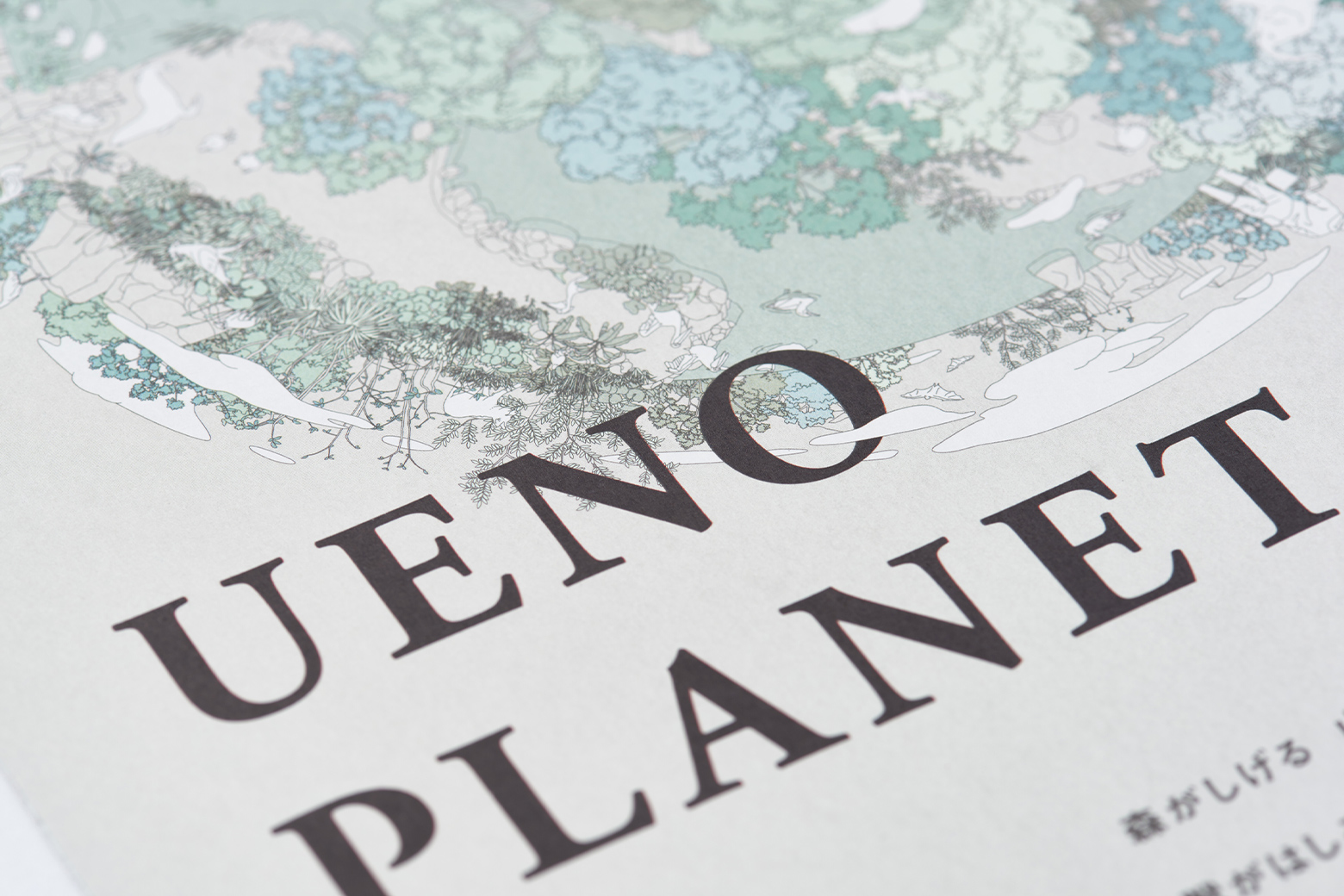
Photo by Keisuke Kitamura
Higashiyama:
Unlike you, I’m mainly in charge of product design, so I find your unrestricted range of work in products,
graphics, and environmental design very stimulating.
Misawa:
From the opposite perspective, I believe it would be impossible for me to do what I do now without respect for
those who are specialized. I like to watch craftsmen at work; I like to listen to biologists talk about their
research; and I like to read the books that people recommend to me. When doing something based solely on my
own expertise, I feel the limits of what I can do. Thanks to the succession of encounters with various people,
I can take on challenges that I could not have done without them, and this makes me happy.
Higashiyama:
You value relationships with people and things.
Repeatedly making choices in search of the right answer
Misawa:
The work titled waterscape was inspired by my experience since elementary school of keeping fish, and so I
felt confident that I could create a never-before-seen aquatic landscape. This thought led me to explore,
through trial and error, the relationship between living creatures by placing various objects in small 20 cm
square tanks for my first solo exhibition. There was no clear line of demarcation between success and failure
because fish are unable to verbally express their feelings. Can this be considered a “functioning” state? What
constitutes an environment in the first place? Just looking at them gave me no answer. I didn't know what I
thought would be the right answer for fish since it would be an exchange between creatures who are incapable
of understanding each other’s language. With no reliable answer, I struggled for a clue and began guessing.
This project is still ongoing and therefore can still be considered in the development stage, but I hope to
create “something that can be observed, even if it cannot be appreciated” and provide form to a perspective
that seeks discovery.
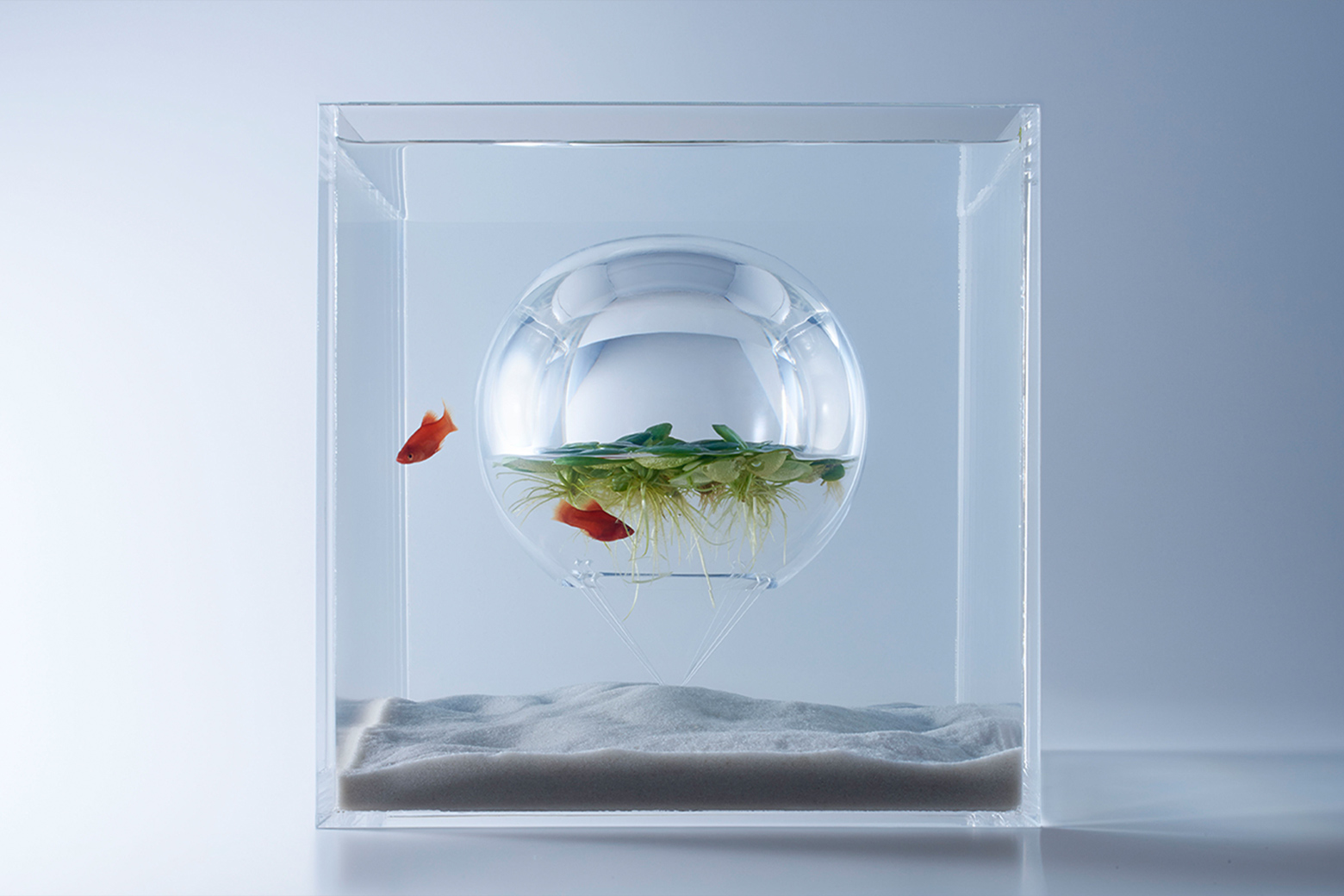
Photo by Masayuki Hayashi
https://www.ndc.co.jp/works/waterscape-2016/
Higashiyama:
In the case of waterscape, the finished forms are very nice, but as a designer, I was interested in the
process sketches in which the various forms were being considered. When you are expanding your ideas, what
axis do you use to decide which ideas to adopt and which to abandon?
Misawa:
In waterscape, I first submerged a resin 3D printer object in the water and let the White Cloud Mountain
minnows swim for a while and made a glass tunnel opening to see how the loaches would react. First, it was
essential that the underwater creatures “use” what I made. There were many cases where I tried introducing
items like tunnels, and the creatures didn’t use them, or rather they didn’t use them before I could know
whether the items were functional. Before determining the functionality of an object, the creatures had to use
it, which they often didn’t like the tunnels that they completely ignored.
Higashiyama:
I see. So, the choice of ideas not only had to do with form but also with how the fish reacted.
Misawa:
Also, if you put something made of concrete in the water, it changes the water quality. When you keep fish,
you usually use safe materials bought from the store. But I didn’t know if the material that I made was safe
for the fish. Needless to say, my attempts included efforts that did not always work out.
Higashiyama:
When I started to think about a new air purifier, I also considered several ideas by drawing sketches and
modeling with 3D CAD, but it was very difficult for me to decide which one was best. I could make some
nice-looking products, but I had trouble making the final decision. However, I always tried to select the one
that seemed the best at the time.
Misawa:
It is always a series of choices to create something and put it out into the world. After repeatedly making
choices, I only present to the world what rises to the top. As I make choices, I abandon many ideas, but I
don't put much emotion into what I choose and don’t choose. In the end, a form emerges from the accumulation
of how I made choices. However, if you abandoned something, does it mean it is inferior? Actually, it is not
necessarily so. It just means that it was your decision at the time. If you keep it in the back of your mind,
you may be able to use it in some different way in the future. I appreciate that kind of thinking. Besides, if
you decide that something is a failure, you won’t know how others will perceive it. Even so, can you go ahead
with your choice with a firm belief? I believe that after you repeatedly make such choices, something finely
honed will naturally emerge.
Leave a blank space rather than stating emphatically
Higashiyama:
In the development of a new air purifier that I was in charge of, I imagined the life of a person who would
use it and asked myself, "What kind of air purifier would suit this person?” I considered the shape and
function of the product, as well as how it would be used in a way that suits the person. I am very interested
to know what kind of person you design for and with what kind of feeling.
Misawa:
I sometimes set targets in cases such as work related to branding, but in the case of exhibitions, I believe
it is important that the visitors who see the exhibition take back something that they experienced to their
daily lives. Visitors all have different values, and someone with values different from mine comes and notices
something completely different, and it is all right if our intentions are not necessarily understood. Of
course, it is important to clarify the work’s intention, but it’s all right if some people are amused by other
aspects. I have become aware that I am probably not good at creating strong designs that say, “Look at this!”
I’m more interested in designs that leave open possibilities -- “It might be this way.” Therefore, I don't
think of the waterscape tank as a finished work. It's more like showing a work in progress.
Misawa:
The title of the 2018 exhibition “Again and Again” also reflects my hope to create a sequel throughout life.
Ideas cultivated in the creation of one work may come to life in another one, as everything is connected
within me. Both stock and failure lead to something. Therefore, rather than asserting “absolutely this,” I
communicate to exhibition visitors with some blank space that “it may be this." Then they begin to think with
their imagination. Rather than asserting something, I would be more pleased if people started to ponder and
think, for example, “I might be able to use this for something.” I leave a great extent to people who
experience the exhibition. Creating that blank space is what I am doing through my exhibitions. I guess, more
than anything else, I always want to be excited by leaving the sequel for the future rather than completing
the final chapter. I have the feeling that I am not showing a finished work but rather a stage in the middle
of a change. It’s like saying, “From here onward, why don't we think together?” This leads to the idea of
“creating with someone," and that someone can be someone I don't know. I am happy when I enter the brain of
that person, or when my thoughts link with other people’s thoughts.
All struggles and failures create something better
Higashiyama:
Perhaps I have been so impressed with your works because I feel the blank spaces.
Misawa:
People who see the exhibits may think, "What would I do if I were... or they may see similar movements on
their way home and make a connection in thinking, “That is like what I saw earlier.” It would be fun for me if
I could create a phenomenon where visitors who left the exhibition venue started thinking, and their thoughts
start moving before they realize it. Because I always ask myself, “Is it right to assert this?” and then say
to myself, “I don't know enough to assert this.” There is a premise that I don't understand, and I don't know
if I am right, but for that very reason, I have no choice but to create. Although the work has taken shape
through a series of choices, if you ask whether it is the right answer, it may not be. But without it, it is
impossible to move on to the next stage. I think I should not stop creating, should not stop thinking, not in
order to complete something, but perhaps because I want to continue to face “not knowing” and connect with
someone beyond that point.
Higashiyama:
It is very interesting that you want to continue to face “not knowing.” And I am attracted to your ideas from
which I feel potential for future expansion and development because you don’t regard the work as a completed
form. However, in the product development of the air purifier, my approach has been to pack everything in and
follow through, rather than leaving any blank spaces.
Misawa:
But there was someone in Daikin who made its first air purifier, and the accumulation and buildup from that
point have led to the latest development today. And 50 years, 100 years, and 1,000 years from now, there will
surely be a future connected from the present. In this respect, you are passing it on like a traditional art,
and in each period, people keep thinking about the product and say, “Maybe this is better.” This looks ahead
to the next era, doesn’t it? Therefore, I am sure that the products you make are also messages that convey,
“This may be better.” The continuity of “maybes,” I think, is an indispensable act in creating a finely honed
and universal work.
Higashiyama:
That's so true, and I myself studied previous designs and certainly felt a kind of difference in the way that
I would have done it. I send out a product that I believe is the best under the present circumstances and hope
to make the user happy as a result, which I suppose never changes throughout the ages.
Looking ahead to changes caused by the pandemic
Higashiyama:
Due to COVID-19, it seems air purifiers, which used to be a value-added item, are now becoming mainstream. I
never imagined that such a big change would happen in my lifetime. I also think this is probably the time for
us to stop and rethink about design because we are in the midst of a change that we can create new things.
Misawa:
I recently edited and organized an exhibition sponsored by the National Museum of Nature and Science titled
“WHO ARE WE: And What Can We Learn From Observation?” and I had an experience which I thought might be
characteristic of the pandemic.
The display stand had 46 drawers, and the visitors had to open them to see what was inside. There were many
valuable items in the drawers, and we wanted the visitors to open them quietly and gently, so we handed the
visitors white gloves at the entrance to the venue and asked them to wear them to touch the drawers. Then
everyone put them on without any resistance. If it had been two years ago, I don't know whether they would
have accepted it so easily. Due to COVID-19, people now have a greater imagination about invisible things such
as air and about wearing masks. I think there are ways to take advantage of these changes.
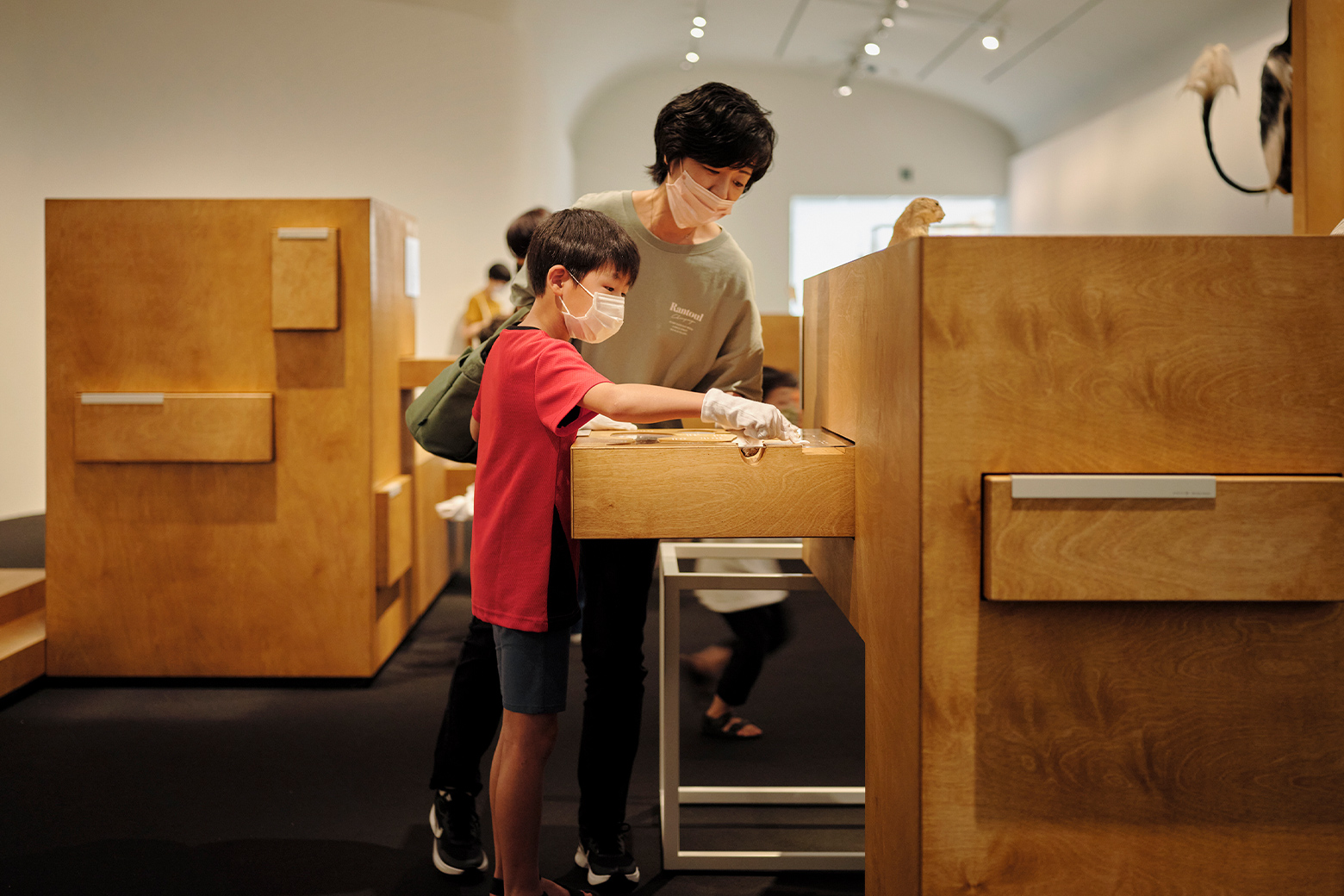
Collection of the National Museum of Nature and Science, Tokyo | Vol. 01 Mammals
Photo by Rico Okaniwa
Higashiyama:
That’s certainly true. I have been struggling to find how to make people feel the comfort and secureness of
air. But now I really agree that the COVID-19 pandemic made people realize the importance of clean air and
changed people's awareness.
It was very inspiring to talk with you since you see things and design without boundaries. I would like to
work on design to deliver better air quality from Daikin while looking at things from a broader perspective
like yours.
Misawa Design Institute, Nippon Design Center
